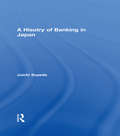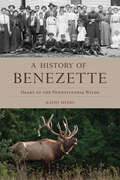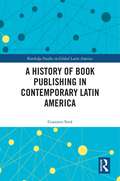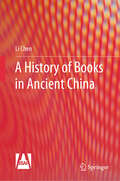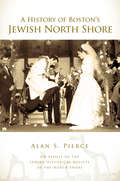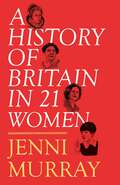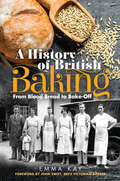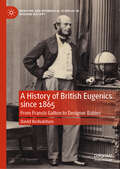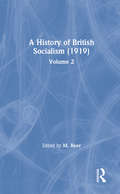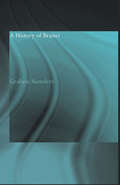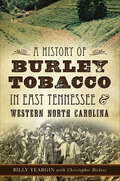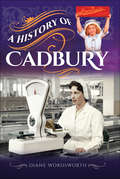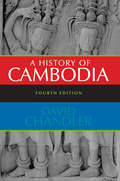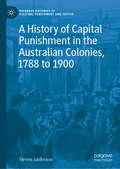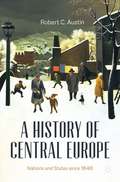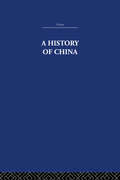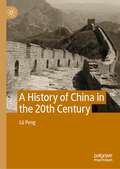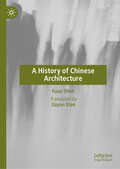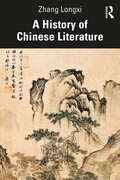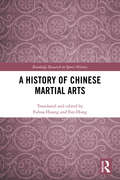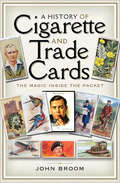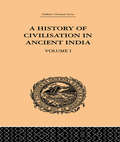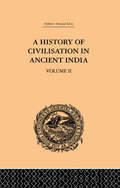- Table View
- List View
A History of Banking in Japan
by Juichi SoyedaFirst Published in 2000. Nothing definite is known about the banking system of the early days of Japan, but it is clear that the system played no important part in affairs, since the insignificance of trade and industry called for no extensive credit arrangements, and the spirit of contempt for business was general. This book looks at the banking system and traces the development of currency in Japan.
A History of Benezette: Heart of the Pennsylvania Wilds (Brief History)
by Kathy MyersFounding the Pennsylvania Wilds and Preserving Elk Country The village of Benezette is ground zero for the famous elk herd of the Pennsylvania Wilds. Before becoming a popular ecotourism destination, the community was a quiet village with a hardworking ethos. The region's first settlers arrived in the 1780s, looking for new frontiers and economic opportunities. Reuben Winslow purchased more than three hundred acres of land along the Bennett's Branch of Sinnemahoning Creek and, by 1844, had laid down the town's lots as the founder of Benezette. The arrival of the Pennsylvania Railroad in the late 1800s fueled the rise of local industry such as timber and coal. Nearby villages such as Weedville, Caledonia, Medix Run, Summerson and others looked to Benezette as the center of the of the region while developing their own communities. Author Kathy Myers presents the history of Benezette and its influence in the heart of the Pennsylvania Wilds.
A History of Book Publishing in Contemporary Latin America (Routledge Studies in Global Latin America)
by Gustavo SoráThis book presents a cultural history of Latin America as seen through a symbolic good and a practice – the book, and the act of publication – two elements that have had an irrefutable power in shaping the modern world. The volume combines multiple theoretical approaches and empirical landscapes with the aim to comprehend how Latin American publishers became the protagonists of a symbolic unification of their continent from the 1930s through the 1970s. The Latin American focus responds to a central point in its history: the effective interdependence of the national cultures of the continent. Americanism, until the 1950s, or Latin Americanism, from the onset of the Cold War, were moral frameworks that guided publishers’ thinking and actions and had concrete effects on the process of regional integration. The illustration of how Latin American publishing markets were articulated opens up broader and comparative questions regarding the ways in which the ideas embodied in books also sought to unify other cultural areas. The intersection of cultural, political and economic themes, as well as the style of writing, makes this book an interest to a wide reading public with historical and sociological sensitivity and global cultural curiosity.
A History of Books in Ancient China
by Li ChenThis book presents a study of the history of ancient Chinese books, not only highlighting specific aspects of the ontology of book history, such as printing and publishing, but also analyzing the internal and external causes of the development of book undertakings from a macro-perspective. Placing the development of and changes in the history of books in the context of social development, it investigates its interaction with politics, economy, society, education, and religion, especially with the big culture, and constructs a book-centered history of ancient Chinese culture.
A History of Boston's Jewish North Shore (American Heritage)
by Alan S. Pierce Jewish Historical Society of the North ShoreForced to flee the brutal pogroms of Europe, Jewish immigrants sought refuge in the beauty of Boston's North Shore. Drawing on their artisan skills, many found work in the tanneries of Peabody and the shoe factories of Lynn, while other enterprising Jews established their own businesses in Salem and Beverly- from butcher shops and groceries to newspapers. Alongside fellow members of the Jewish Historical Society of the North Shore, Alan Pierce has carefully assembled a collection of personal histories from generations of Jewish families. Celebrating the rich flavors of Jewish culture, these accounts capture familiar faces, such as renowned athlete Herb Brenner, and recognizable landmarks like the Kernwood Country Club and the Dolphin Yacht Club, innovative establishments open to all regardless of race or religion. With entrepreneurial spirit, a little determination and plenty of faith, the North Shore's storied Jewish communities have etched enduring marks on its streets and in its synagogues.
A History of Britain in 21 Women: A Personal Selection
by Jenni MurrayBritain has been defined by its conflicts, its conquests, its men and its monarchs. To say that it's high time that it was defined by its women falls some way short of an understatement. Jenni Murray draws together the lives twenty-one women to shed light upon a variety of social, political, religious and cultural aspects of British history. In lively prose Murray reinvigorates the stories behind the names we all know and reveals the fascinating tales behind those less familiar, ultimately producing a unique history of Britain that is as long-overdue as it is absorbing. From famous queens to forgotten visionaries, and from great artists to our most influential political actors, A History of Britain in 21 Women is a veritable feast of page-turning history. A History of Britain in 21 Women will profile Boudicca, Aphra Behn, Elizabeth I (this chapter will also feature Anne Boleyn and Mary Queen of Scots), Fanny Burney, Jane Austen, Mary Wollstonecraft, Constance Markievicz, Nancy Astor, Ada Lovelace, Caroline Herschel, Elizabeth Garrett Anderson, Millicent Garrett Fawcett, Emmeline Pankhurst, Gwen John, Rosalind Franklin, Ethel Smyth, Margaret Thatcher, Nicola Sturgeon, Mary Quant, Barbara Castle and Mary Somerville.
A History of British Baking: From Blood Bread to Bake-Off
by Emma KayA cultural and social history of Britain’s breads, cakes, and pastries through the ages, from the author of Dining with the Victorians.The Great British Baking Show and its spinoffs are a modern-day phenomenon, but the British, of course, have been baking for centuries—and here, for the first time, is a comprehensive account of how Britain’s relationship with this much-loved art has changed, evolved, and progressed over time.Renowned food historian Emma Kay skillfully combines the related histories of Britain’s economy, innovation, technology, health, and cultural and social trends with the personal stories of many of the individuals involved with the whole process: the early pioneers, the recipe writers, the cooks, the entrepreneurs. From pies to puddings, medieval ovens to modern-day mass consumption, the result is a deliciously fascinating read.
A History of British Eugenics since 1865: From Francis Galton to Designer Babies (Medicine and Biomedical Sciences in Modern History)
by David RedvaldsenThis book examines British eugenics from its origins in 1865 to the early 1990s. It considers the two institutions promoting the doctrine: the Galton Laboratory attached to the University of London; and the Eugenics Society. It charts internal and ideological changes across more than a century, seeing eugenics as primarily a political movement. The doctrine had influence on British society and guided adherents ranging from scientists to charitable ladies. The Galton Laboratory published detailed studies of heredity. It transformed itself into a centre for medical genetics after the Second World War. As early as the 1920s, the Eugenics Society was the mainspring of the doctrine, formulating what became the British version of an international ideology. It began as applied social Darwinism, later incorporating a greater degree of meritocracy and amelioration. Its support for sterilization in the 1930s eroded the kudos it had gained in policy-making circles. From the 1960s, organized eugenics was especially a forum for learned and popular discussion of biology and sociology. Medical advances after 1970 aided its continuation, notably the growth of assisted reproductive technologies. The book presents British eugenics as mostly shaped by domestic concerns, offering new revelations and interpretations with the capacity to readjust historical thinking. It also covers contemporary bioethical and political issues aligned to eugenics.
A History of British Publishing
by John FeatherThoroughly revised, restructured and updated, A History of British Publishing covers six centuries of publishing in Britain from before the invention of the printing press, to the electronic era of today. John Feather places Britain and her industries in an international marketplace and examines just how ‘British’, British publishing really is. Considering not only the publishing industry itself, but also the areas affecting, and affected by it, Feather traces the history of publishing books in Britain and examines: education politics technology law religion custom class finance, production and distribution the onslaught of global corporations. Specifically designed for publishing and book history courses, this is the only book to give an overall history of British publishing, and will be an invaluable resource for all students of this fascinating subject.
A History of British Socialism: Volume 2 (Routledge Library Of British Political History Ser.)
by M. BeerThis is volume 2 of the set A History of British Socialism. These volumes study the political thought experienced as a result of the massive transition of the British countryside to capitalist agriculture and capitalist industry.
A History of Brunei
by Graham SaundersThe only full-length study of the Brunei Sultanate from the earliest times to the present. First published in 1994 and a sell-out success, RoutledgeCurzon is pleased to present this new edition, updated to the present. Saunders skilfully elucidates historiographical controversies over important events, persons and developments in Brunei's past which are still important issues in defining Brunei's identity and its political and social systems today. These controversies, over the antecedents of the Sultanate, the date of the conversion to Islam, the reigns of the early sultans, early contacts with Europeans and others, retain their relevance. Newly presented are interpretations of events since 1945 during the transition from protected state to full independence, and thence to the present Malay Islamic Monarchy.
A History of Burley Tobacco in East Tennessee & Western North Carolina
by Billy YearginBurley tobacco revolutionized the industry in east Tennessee and western North Carolina. What started from two farmers planting white burley in Greeneville ignited an agricultural revolution and significantly changed crops, production and quality. Burley transformed the tobacco industry with new cultivation techniques and a shift from dark and flue-cured tobacco. By the 1990s, burley tobacco production in the region had drastically declined, and it is a tradition that few local farmers still practice. Agricultural experts Billy Yeargin and Christopher Bickers take a nostalgic look at the historic rise of burley tobacco and its gradual decline.
A History of Cadbury
by Diane WordsworthThe history of the world-famous confectioner—maker of the Cadbury Creme Egg—from nineteenth-century shop to multinational brand. When John Cadbury came to Birmingham in 1824, he sold tea, coffee, and drinking chocolate in a small shop on Bull Street. Drinking chocolate was considered a healthy alternative to alcohol, something Cadbury, a Quaker, was keen to encourage. By 1879, the Cadburys were ready to make their historic move to Bournville, where they established their famous &“factory in a garden,&” built on the sprawling Bournbrook estate. A History of Cadbury recounts the history of this beloved British chocolatier and looks at the social impact the company has had, both on the chocolate and cocoa business and on British culture at large. This is the story of how Cadbury began, how it grew, and how it diversified in order to bring its chocolates and candies to one generation after the next.
A History of Cambodia
by David ChandlerIn this clear and concise volume, author David Chandler provides a timely overview of Cambodia, a small but increasingly visible Southeast Asian nation. Praised by the Journal of Asian Studies as an ''original contribution, superior to any other existing work'', this acclaimed text has now been completely revised and updated to include material examining the early history of Cambodia, whose famous Angkorean ruins now attract more than one million tourists each year, the death of Pol Pot, and the revolution and final collapse of the Khmer Rouge. The fourth edition reflects recent research by major scholars as well as Chandler's long immersion in the subject and contains an entirely new section on the challenges facing Cambodia today, including an analysis of the current state of politics and sociology and the increasing pressures of globalization. This comprehensive overview of Cambodia will illuminate, for undergraduate students as well as general readers, the history and contemporary politics of a country long misunderstood.
A History of Capital Punishment in the Australian Colonies, 1788 to 1900 (Palgrave Histories of Policing, Punishment and Justice)
by Steven AndersonThis book provides a comprehensive overview of capital punishment in the Australian colonies for the very first time. The author illuminates all aspects of the penalty, from shortcomings in execution technique, to the behaviour of the dying criminal, and the antics of the scaffold crowd. Mercy rates, execution numbers, and capital crimes are explored alongside the transition from public to private executions and the push to abolish the death penalty completely. Notions of culture and communication freely pollinate within a conceptual framework of penal change that explains the many transformations the death penalty underwent. A vast array of sources are assembled into one compelling argument that shows how the ‘lesson’ of the gallows was to be safeguarded, refined, and improved at all costs. This concise and engaging work will be a lasting resource for students, scholars, and general readers who want an in-depth understanding of a long feared punishment.Dr. Steven Anderson is a Visiting Research Fellow in the History Department at The University of Adelaide, Australia. His academic research explores the role of capital punishment in the Australian colonies by situating developments in these jurisdictions within global contexts and conceptual debates.
A History of Central Europe: Nations and States Since 1848
by Robert C. AustinThis textbook offers a survey of the history of Central Europe since 1848, from the ‘Springtime of Nations’, through the world wars and communist period, to NATO and EU membership. With an emphasis on nation-building, it gives the reader a better understanding of not just political history but also of the region’s economic development and of everyday life. The book brings the reader right up to the present, considering contemporary issues such as the impact of the 2015 refugee crisis, migration out of Central Europe, the weakening of democratic institutions and the re-emergence of nationalism. Throughout, it offers fresh perspectives, gives agency to Central Europe, and pays attention to the ethnic, linguistic and religious diversity of the region. This is essential reading for students taking courses on Central/East-Central Europe. It is also suitable for courses on 19th and 20th Century Europe, or for anyone with an interest in the region.
A History of China
by Wolfram EberhardFirst published in 1950. This re-issues the fourth edition of 1977. This is a social history of China, presenting the main lines of development of the Chinese social structure from the earliest times to the present day. The book discusses the origins of the present regime and developments in China in the last years, and political, social and cultural changes are all analyzed. The text is based upon the study of original Chinese sources and also the work of Chinese, Japanese and Western scholars.
A History of China in the 20th Century
by Lü PengThis book provides readers with rich context and detailed description leading to new perspectives on major historical events in China. Positioned as a thought leader and highly acclaimed arts professional in China, the author is able to give a historical account of China’s twentieth century that is richly informed by its valent fields of political economy and cultural studies. Western readers' knowledge of China’s twentieth century remains based on pioneering research of modern scholars such as Fairbank and Jonathan Spence. In recent years, however, it is rare to see a complete history of China spanning the nineteenth and twentieth centuries which also includes the first two decades of the twenty-first century. This book contributes new narrative and perspective to this span of history. Now, as the Sino-US trade conflict makes dramatic impact on a post-COVID global economy, readers have the need for a fresh understanding of how China came to be what it is today. The author’s groundbreaking work provides new insight provided by newly uncovered sources explaining how China came to be what it is today from a cultural and sociological perspective, in a historical mode.
A History of Chinese Architecture
by Fuxu ShenThis book provides a comprehensive examination of the architectural evolution of China from antiquity to the early modern, modern, and contemporary ages. A comprehensive examination of the evolution of Chinese architecture is presented in nine chapters, offering a penetrating survey of the subject matter for both learners and professionals. Each chapter illuminates the architectural styles, cultural implications, social significance, and innovations that have shaped the development of Chinese architecture across all dynasties and epochs, from the prehistoric era to the present day. Furthermore, the book draws on past predictions and promising trends in the future of Chinese architecture, thus offering a distinctive perspective on the history of Chinese architecture.
A History of Chinese Literature
by Zhang LongxiZhang Longxi, an internationally renowned scholar of Chinese and comparative literature, is your guide to the three-millennia-long history of Chinese literature from the remote antiquity of oracle bones to contemporary works. Professor Zhang charts the development of the major literary forms in Chinese, including poetry, prose, song lyrics, and plays, and introduces the most famous poets and writers and their representative texts. Taking a period-based approach through the major dynasties, he places these forms, texts, and authors within their historical contexts and tells the fascinating story of Chinese literature with copious examples in English translation. He writes in a clear and accessible style and assumes no prior knowledge of Chinese history or Chinese literature. This book is an ideal introduction for students and the general readers who want to get a broad but thorough overview of Chinese literature in all its richness and diversity.
A History of Chinese Martial Arts (Routledge Research in Sports History)
by Fan Hong Fuhua HuangChinese martial arts have a long, meaningful history and deep cultural roots. They blend the physical components of combat with strategy, philosophy and tradition, distinguishing them from Western sports. A History of Chinese Martial Arts is the most authoritative study ever written on this topic, featuring contributions from leading Chinese scholars and practitioners. The book provides a comprehensive overview of all types of Chinese martial arts, from the Pre-Qin Period (before 222 BC) right up to the present day in the People’s Republic of China, with each chapter covering a different period in Chinese history. Including numerous illustrations of artefacts, weaponry and historical drawings and documents, this book offers unparalleled insight into the origins, development and contemporary significance of martial arts in China. This is a fascinating read for researchers and students working in sports history, Chinese sport and Chinese Studies.
A History of Cigarette and Trade Cards: The Magic Inside the Packet
by John BroomHow trading cards captured the popular culture—from war to sports, science to celebrities—with tips on how to start and develop your own collection. The collection of picture cards has fascinated generations of children and adults since the late nineteenth century. Between 1900 and 1940, cartophily, as the hobby became known, became widespread as hundreds of millions of attractive cards were issued, usually with packets of cigarettes. These cards give us a unique insight into the cultural history of the period. Although the production of cigarette and other trade cards has declined in recent decades, millions of people worldwide now collect trading cards and stickers issued by the likes of Topps and Panini. This attractive and extensively illustrated guide to collecting cigarette and other trade cards gives the reader a lively history of the hobby, and offers the collector some valuable advice on how to begin and maintain a collection. The wide variation of themes of card issues is explored, with many of the stories behind the cards revealed. It will appeal to novice and established card collectors, and those with an interest in twentieth century social and cultural history.
A History of Civilisation in Ancient India: Based on Sanscrit Literature: Volume I
by Romesh Chunder DuttFirst Published in 2000. Routledge is an imprint of Taylor & Francis, an informa company.
A History of Civilisation in Ancient India: Based on Sanscrit Literature: Volume II
by Romesh Chunder DuttFirst Published in 2000. This title is Volume 4 in the 11-volume series titled India: History, Economy and Society, one of the Trüber's Oriental Series. This title tackles the great task of compiling, for the first time, a connected and clear history of the Ancient Hindus. The first chapters on the Vedic Age were commenced in April 1887, the last chapters on the Puranic Age have been revised in March 1890. The entire edition of a thousand copies has been nearly exhausted for this collection.
A History of Civilization in 50 Disasters (History in #50)
by Phillip Hoose Gale EatonThe earth shakes and cracks open. Volcanoes erupt. Continents freeze, bake, and flood. Droughts parch the land. Wildfires and hundred-year storms consume anything in their paths. Invisible clouds of disease and pestilence probe for victims. Tidal waves sweep ashore from the vast sea. The natural world is a dangerous place, but one species has evolved a unique defense against the hazards: civilization. Civilization rearranges nature for human convenience. Clothes and houses keep us warm; agriculture feeds us; medicine fights our diseases. It all works--most of the time. But key resources lie in the most hazardous places, so we choose to live on river flood plains, on the slopes of volcanoes, at the edge of the sea, above seismic faults. We pack ourselves into cities, Petri dishes for germs. Civilization thrives on the edge of disaster. And what happens when natural forces meet molasses holding tanks, insecticides, deepwater oil rigs, nuclear power plants? We learn the hard way how to avoid the last disaster--and maybe how to create the next one. What we don't know can, indeed, hurt us. This book's white-knuckled journey from antiquity to the present leads us to wonder at times how humankind has survived. And yet, as Author Gale Eaton makes clear, civilization has advanced not just in spite of disasters but in part because of them. Hats off to human resilience, ingenuity, and perseverance! They've carried us this far; may they continue to do so into our ever-hazardous future. The History in 50 series explores history by telling thematically linked stories. Each book includes 50 illustrated narrative accounts of people and events--some well-known, others often overlooked--that, together, build a rich connect the-dots mosaic and challenge conventional assumptions about how history unfolds. Dedicated to the premise that history is the greatest story ever told. Includes a mix of "greatest hits" with quirky, surprising, provocative accounts. Challenges readers to think and engage. Includes a glossary of technical terms; sources by chapter; teaching resources as jumping-off points for student research; and endnotes.
